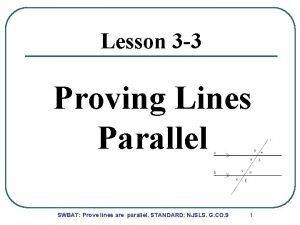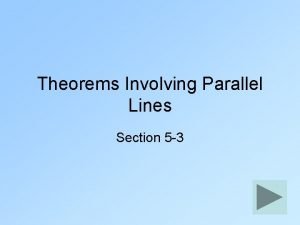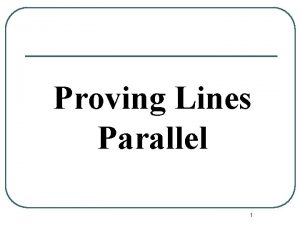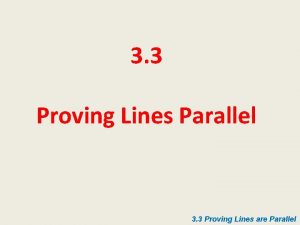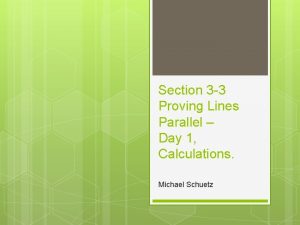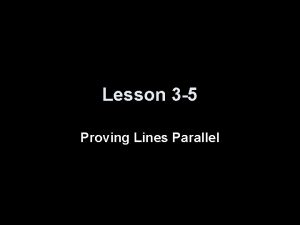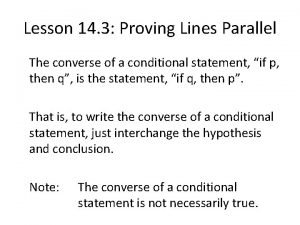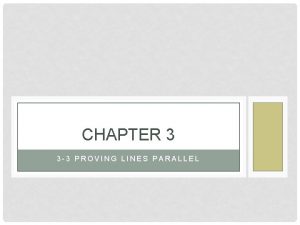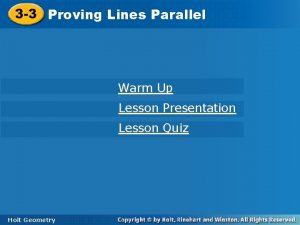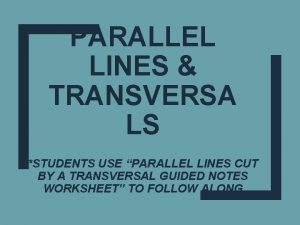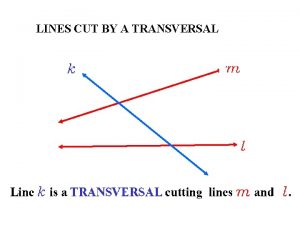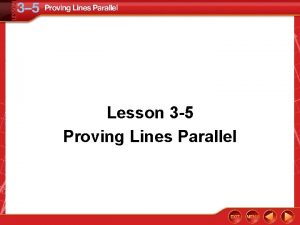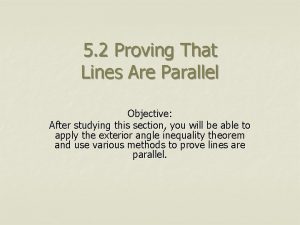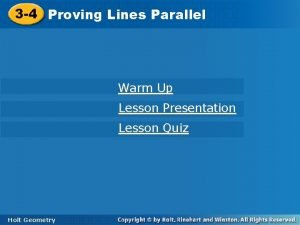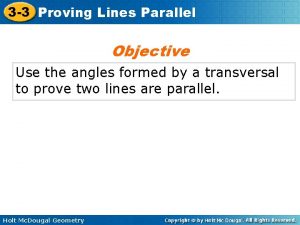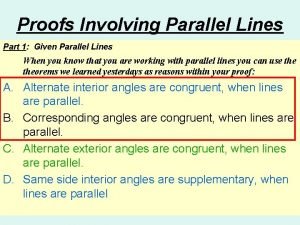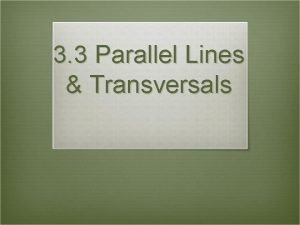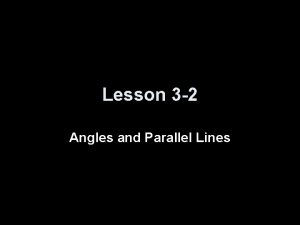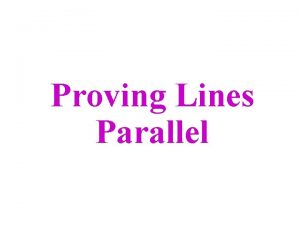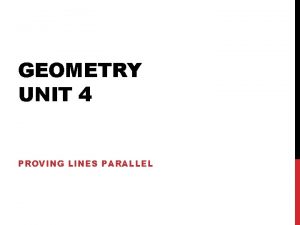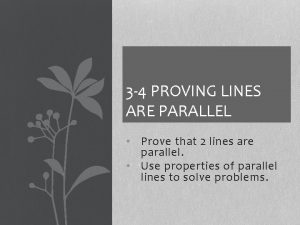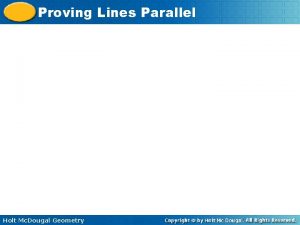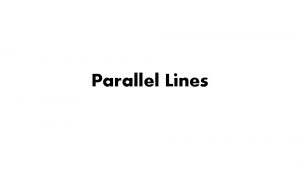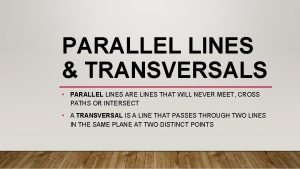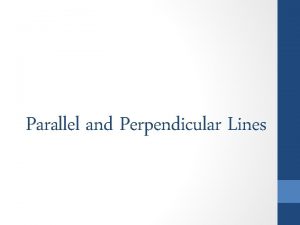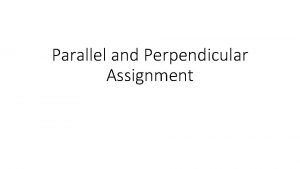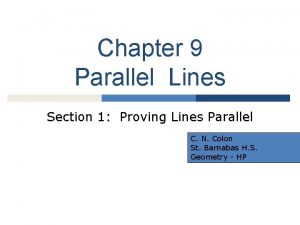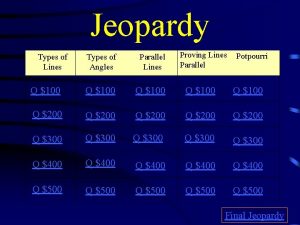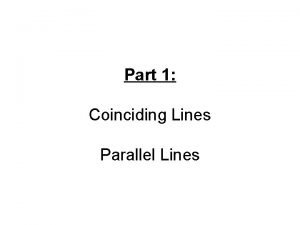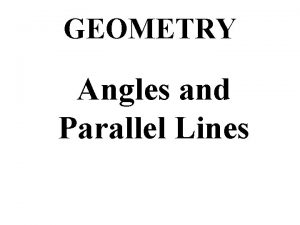Unit 3 Proving Lines are Parallel Prove Theorems




















- Slides: 20

Unit 3 Proving Lines are Parallel Prove Theorems about Perpendicular lines

Name Corresponding Angles Converse Description If ____ 1 _____, 5 then m n

Name Alternate Interior Angles Converse Description If ____ 3 _____, 6 then m n

Name Alternate Exterior Angles Converse Description If ____ 1 _____, 7 then m n

Name Description Consecutive Interior 180° If ____ + _____ = _____, then 3 5 Angles Converse m n

1. Is there enough information to prove the lines are parallel? If yes, state theorem you used. Yes, Corresponding Angles Converse

1. Is there enough information to prove the lines are parallel? If yes, state theorem you used. No

1. Is there enough information to prove the lines are parallel? If yes, state theorem you used. Yes, Alternate Interior Angles Converse

2. What value of x makes theorem you used. ? State which Alternate Exterior Angles Converse 5 x + 20 = 90 5 x = 70 x = 14°

2. What value of x makes theorem you used. ? State which Corresponding Angles Converse 4 x – 28 = 100 4 x = 128 x = 32°

2. What value of x makes ? State which theorem you used. Consecutive Interior Angles Converse 2 x + 36 + 4 x = 180 6 x + 36 = 180 6 x = 144 x = 24

intersect If two lines __________ to form a linear pair of ________ angles, then the congruent lines are __________. perpendicular

If two lines are __________, then perpendicular they intersect to form four _______ right angles.

If two sides of two adjacent acute angles are perpendicular ___________, then the angles are complementary ____________. A B C

perpendicular If a transversal is ____________ to one of two parallel lines, then it is perpendicular ___________ to the other.

In a plane, if two lines are perpendicular __________ to the same line, then parallel they are _________ to each other.

1. 2 x + 18 + 36 = 90 2 x + 54 = 90 2 x = 36 x = 18°

1. 3 x – 11 + 38 = 90 38° 3 x + 27 = 90 3 x = 63 x = 21°

HW Problem LT 3. 1, 3. 2, 3. 3 165 -168 3, 5, 6, 8, 10 -15, 19 194 -197 1, 5 -7, 17, 21, 31 (copy table) #31

m 1 + m 2 = 180 Def. of linear pair Def. of angles 1 is a right angle Division Prop. Def. of perp. lines
 Mikael ferm
Mikael ferm Proving lines parallel 3-3 answers
Proving lines parallel 3-3 answers 5-3 theorems involving parallel lines
5-3 theorems involving parallel lines Geometry proving lines parallel
Geometry proving lines parallel 5 ways to prove lines are parallel
5 ways to prove lines are parallel Proving lines parallel
Proving lines parallel Proving lines parallel with algebra
Proving lines parallel with algebra 3-3 proving lines parallel part 1 answers
3-3 proving lines parallel part 1 answers Lesson 3-5 proving lines parallel
Lesson 3-5 proving lines parallel Proving lines are parallel worksheet answers 14-3
Proving lines are parallel worksheet answers 14-3 3-3 proving lines parallel
3-3 proving lines parallel Proving lines parallel examples
Proving lines parallel examples Parallel lines and transversals notes
Parallel lines and transversals notes 7-2 proving lines are parallel
7-2 proving lines are parallel Lesson 3-5 proving lines parallel
Lesson 3-5 proving lines parallel Proving lines parallel worksheet 3-3
Proving lines parallel worksheet 3-3 Lesson 4-3 proving lines are parallel
Lesson 4-3 proving lines are parallel 3-3 proving parallel lines
3-3 proving parallel lines Proofs involving parallel and perpendicular lines
Proofs involving parallel and perpendicular lines 1 - 55
1 - 55 Section 3-2 angles and parallel lines
Section 3-2 angles and parallel lines

